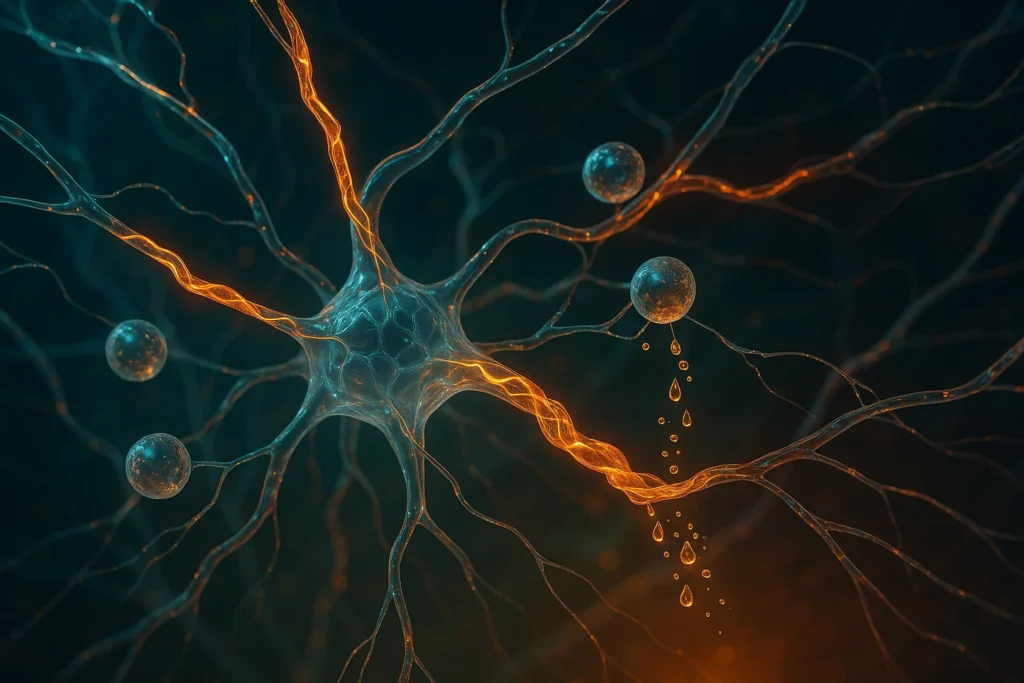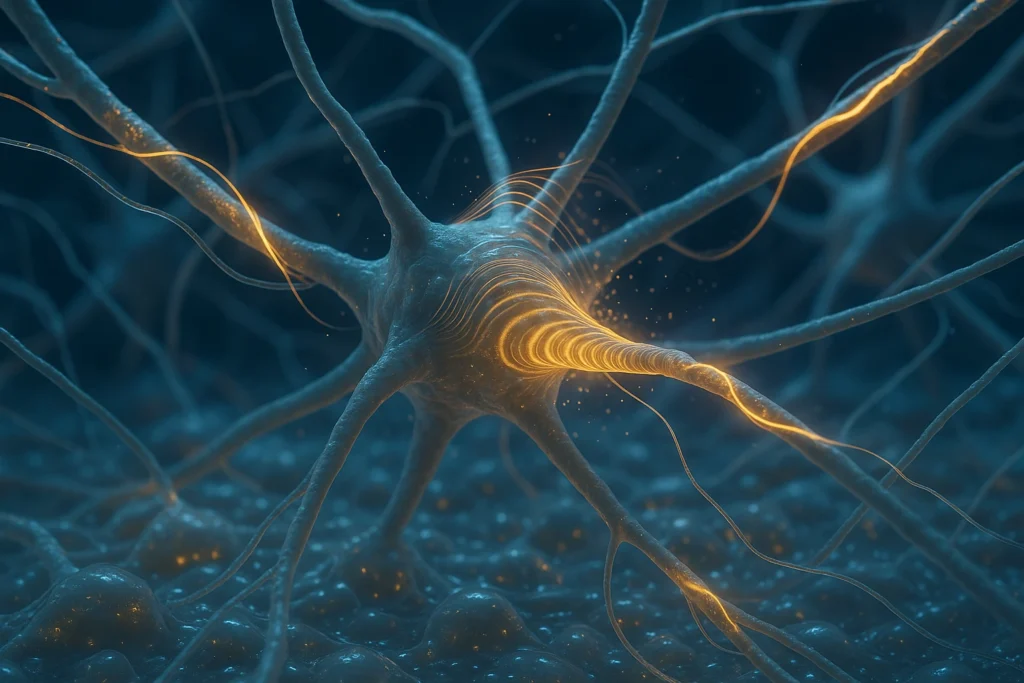1. Introduction: From Passive Pills to Intelligent Neuroresponsive Therapies
Picture this: A patient with Parkinson’s disease takes a tablet, but instead of releasing its contents at a fixed rate, the formulation “listens” to neural signals, delivering dopamine precisely when the brain’s dopaminergic activity dips. No wearable sensors, no manual dose adjustments, just a silent, continuous dialogue between neurons and molecules.
It sounds like science fiction, yet the foundations are already being laid in today’s labs. Over the last decade, bioelectronics, electro-responsive polymers, and AI-assisted drug design have evolved to the point where neuroresponsive formulations that sense and respond to neural activity are no longer an abstract dream. We are entering the era of neuro-responsive drug formulations, medicines that don’t just act on the brain, but act with it.
The story of Neuroresponsive formulation has always been one of evolution, a slow but determined climb toward intelligence. What began as simple mixtures of powders and binders has transformed into a field where materials can feel, respond, and even anticipate the body’s needs.
It started quietly, in the mid-20th century, with pH-dependent coatings, thin polymer layers that dissolved only when they reached the acidic stomach or the neutral intestine. They were clever for their time, letting drugs “choose” where to release, but they were still blind. These neuroresponsive formulations followed chemistry, not physiology; they reacted to pH, not to the patient’s condition.
Then came thermo-responsive gels, polymers that changed structure with temperature shifts, thickening or liquefying in tune with the body’s warmth. For the first time, medicine seemed to possess awareness, adapting to the environment it entered. That small step from static to responsive was revolutionary. It inspired scientists to ask:
What if a drug could respond not just to heat or acidity, but to the living signals of the human body itself?
Fast forward to the 21st century, and that question has begun to find answers. The convergence of biomaterials, nanotechnology, and digital control systems birthed AI-controlled drug delivery platforms. These systems use feedback loops, sensors detecting glucose or pH, algorithms predicting dosage, to release medicines precisely when needed. They marked the transition from reactive to predictive therapies. Diabetic patients saw it first: insulin pumps powered by machine learning algorithms that adjusted doses minute by minute, responding to real-time sugar fluctuations. The age of smart formulations had arrived.
Enter neuroresponsive formulations, the next evolutionary step in intelligent drug delivery. These are not passive capsules waiting for the right pH or temperature. They are living materials, designed to sense and interpret the body’s neural signals. When neurons fire, when an electrical pulse races down a nerve, these neuroresponsive formulations can detect the change and respond, by releasing a molecule, altering structure, or initiating a cascade of therapeutic action.
Imagine! a patient with chronic pain whose medication doesn’t flood their entire system at once, but instead whispers into action the moment their nerve pathways flare up. Or a Parkinson’s capsule that senses when dopamine activity drops and releases the drug only then, maintaining balance without overdose or delay.
That’s the promise of neuroresponsive formulations, a world where medicines listen before they act. They don’t simply deliver a drug; they participate in a conversation with the nervous system, responding to real-time physiological cues.
The journey from pH-sensitive coatings to neural-sensing materials mirrors the evolution of medicine itself, from chemistry to consciousness. We’ve moved from reactive formulations that obey fixed rules to intelligent systems that learn, adapt, and synchronize with human biology.
The next chapters in this story will not be written in chemical equations alone, but in the language of neurons, ions, and electric whispers.
2. The Foundations in the Real World

Tiny nanoscale capsules shimmer along the neuron branches, releasing golden droplets of drug molecules in response to electrical pulses. Every revolutionary concept begins as a bridge, one foot in science fiction, the other in the laboratory. Neuroresponsive formulations are no different. Though the vision of a drug that “listens” to the brain is still taking shape, its building blocks already exist, scattered across pioneering domains like bioelectronic medicine, electroresponsive polymers, closed-loop neural systems, and neural-integrated biomaterials.
Each represents a piece of a puzzle that, when assembled, could redefine what it means for a neuroresponsive formulation to be intelligent.
2.1 Bioelectronic Medicine: Proof That the Brain Can Direct Therapy
The idea that the brain can instruct the body’s healing processes through electricity isn’t new, what’s new is how precisely we’re learning to listen and speak back.
Companies like SetPoint Medical and Galvani Bioelectronics are leading the charge in what’s now called bioelectronic medicine, therapies that use mild, targeted nerve stimulation to modulate disease.
SetPoint’s clinical studies in rheumatoid arthritis have shown that tiny, precisely timed electrical pulses along the vagus nerve can calm inflammation, without a single molecule of immunosuppressant. Similarly, Galvani Bioelectronics (a GlaxoSmithKline and Verily collaboration) is exploring electrical modulation for diabetes and depression, using controlled impulses to rebalance biochemical signaling.
These are not science experiments; they are living proof that electrical language can rewrite physiological behavior, and that the nervous system can become a therapeutic switchboard.
For neuroresponsive formulations, this is the conceptual green light: if electricity can control biology, then biology’s electricity can control chemistry.
2.2 Electroresponsive Polymers: From Lab to Neural Interfaces
Where bioelectronics teaches us that electrical control is possible, electroresponsive materials show us how to translate it into drug delivery.
These advanced polymers, like polypyrrole, graphene oxide, and PEDOT:PSS, act like living conductors, shifting their structure, charge, or even permeability when touched by a subtle electric field.
At the University of Toronto (2022), researchers developed a polypyrrole-based gel that released dexamethasone, a corticosteroid used to prevent inflammation, when exposed to gentle voltage currents. What’s remarkable isn’t just the precision, but the scale: the polymer could respond to electrical fields similar to those produced by neural activity.
Meanwhile, scientists at the Karolinska Institute (2024) embedded PEDOT:PSS nanogels into neural electrodes, creating the first hybrid material that could both record neural signals and release anti-inflammatory drugs on command. These systems essentially blur the boundary between neuroresponsive formulation and electronics, turning conductive materials into responsive carriers that pulse with the rhythm of the brain.
Imagine! a hydrogel coating on a brain implant that listens to local electrical chatter, then quietly releases a therapeutic when inflammation begins, before symptoms even appear.
That’s not future fiction. It’s already in peer-reviewed literature.
2.3 Closed-Loop Neuromodulation: The Functional Precedent
Before neuroresponsive formulations can “think,” we must prove that the body can already talk, and that’s precisely what closed-loop neuromodulation has achieved.
The NeuroPace RNS System, approved by the U.S. FDA for epilepsy, is the most compelling demonstration yet. Implanted directly into the skull, it continuously monitors brain activity, detects the early signatures of a seizure, and instantly delivers a pulse of stimulation that interrupts it before it manifests.
In essence, it is a real-time feedback system between brain and therapy, a living dialogue of signal and response.
Taking that concept further, MIT’s 2023 breakthrough unveiled a miniaturized intraneural micro-pump capable of delivering microdoses of drug molecules in response to specific brainwave thresholds. When neurons misfire, the pump releases precise volumes of medicine, rebalancing neural activity at its source.
These technologies prove something profound: a closed loop between neural activity and therapy already exists. The next logical leap, and perhaps the most thrilling one, is embedding that intelligence within the formulation itself, eliminating the need for external implants.
2.4 Neural-Integrated Biomaterials: The Crossroads of Formulation and Neuroengineering
The frontier where materials meet neurons is perhaps the most beautiful, and delicate, of all. It’s the moment where matter begins to listen.
At Kyoto University (2024), researchers created hydrogels capable of releasing neurotrophic factors only when they detect shifts in the electrical potential of injured spinal tissue. In practical terms, this means a material that “feels” neural distress and responds by nurturing regrowth.
Meanwhile, at the University of Illinois (2023), scientists introduced magnetoelectric nanoparticles, microscopic hybrids that translate neural electrical fields into mechanical changes at the nanoscale. These shifts trigger the controlled release of encapsulated drugs, effectively transforming electrical activity into a chemical signal.
For the first time, the brain’s own electrical language can command the timing and rate of drug release, without external circuits or batteries.
This is where the borders blur entirely: materials that think, neurons that instruct, and drugs that obey.
3. How It Works: The Science of Neuroresponsiveness

A mesmerizing close-up of neural tissue intertwined with glowing polymer filaments, where each nerve impulse sends cascading ripples of light through a translucent gel matrix that releases microscopic drug particles in real time. The scene captures the poetry of science, a living symphony where neurons and smart materials communicate in pulses of energy and color. Surround the composition with a soft teal-gold glow, symbolizing the harmony of biology and technology, evoking a futuristic yet deeply organic atmosphere
Imagine! a formulation that doesn’t wait for a timer or a pH change, but listens to the body. At the heart of neuroresponsive drug delivery lies transduction, the conversion of a biological signal (like an electrical impulse from a neuron) into a physical action that controls when and how a drug is released.
In the simplest sense, the formulation behaves like a microscopic circuit board woven into biological tissue. When a neuron fires or a group of cells produce subtle voltage shifts, the material senses that change, and responds, either by expanding, releasing ions, or changing structure to let the medicine flow.
3.1 Mechanisms of Neuroresponsive Formulation Design
| Mechanisms | Example Materials | Response Trigger | Output (Drug Response) |
| Conductive polymers | Polypyrrole (PPy), PEDOT:PSS | Neural electric potential | Ion exchange → drug diffusion |
| Piezoelectric nanocrystals | nO, BaTiO₃ composites | Neuronal firing strain | Structural deformation → release |
| Magnetoelectric nanoparticles | Fe₃O₄–PZT hybrids | Magnetic field fluctuations in neural tissue | Heat or micro-motion → microcapsule rupture |
| Ionic gels | Alginate–graphene oxide (GO) blends | Local potential shifts | Swelling/deswelling → pulsatile release |
3.2 The Neuro-Biophysical Logic Behind It
When neurons communicate, they create electric fields in the microvolt range. These may seem minuscule, but to an electroresponsive polymer or nanoparticle, that’s enough to cause a cascade of molecular rearrangements. For example:
- Polypyrrole-based gels act like molecular sponges. Under resting potential, they remain contracted, holding the drug within their matrix. When a neuron fires nearby, the electric field causes a local oxidation–reduction shift, altering the polymer’s charge density. This triggers an exchange of ions with the surrounding fluid, and the drug diffuses out.
- Piezoelectric nanocrystals such as ZnO behave differently. They physically deform when exposed to the mechanical strain of firing neurons or even local vibrations from tissue contraction. That deformation opens nano-pores or micro-channels within the material, allowing precise, on-demand release.
Similarly, magnetoelectric nanoparticles convert weak magnetic signals generated by neural currents into mechanical motion or localized heat. These can rupture nano-capsules or trigger conformational changes that release the encapsulated drug payload.
Even ionic gels, which might sound simple, are remarkably elegant. When the electrical potential in their microenvironment changes, their internal ion balance shifts. They either swell (allowing drug diffusion) or contract (locking the drug in). This enables “pulsatile” delivery, small rhythmic bursts that align with neural activity itself.
3.3 Synchronizing Chemistry with Thought
One of the most fascinating advances in this area is the ability to tune formulations to specific neural frequencies. For instance, a formulation designed to treat Parkinson’s disease could be engineered to respond selectively to the brain’s beta-wave activity (13–30 Hz), releasing dopamine agonists only during certain neural oscillations. It’s a shift from chemical time-release systems to electrical intelligence, a formulation that “knows” when to act, guided by the brain’s own language.
3.4 Constraints and Chances
Of course, designing such systems is incredibly delicate. Neural fields vary between individuals and even fluctuate minute to minute. The biggest challenge is ensuring that these materials remain biocompatible, non-toxic, and responsive to the right signal thresholds, not just random noise.
But progress is accelerating. Teams at the University of California, Berkeley and EPFL Lausanne are now embedding graphene micro-electrodes inside hydrogel matrices to “train” materials to recognize neural signatures, much like teaching a neural network to identify brainwave fingerprints. Over time, this could allow adaptive formulations that evolve in synchrony with the patient’s own neurophysiology.
The Vision Ahead: The dream of neuroresponsive drug delivery isn’t just about smarter materials, it’s about partnership. It imagines a medicine that doesn’t merely sit in the body, waiting to dissolve, but instead listens, learns, and acts in rhythm with the nervous system. It’s where formulation meets consciousness, where chemistry becomes conversation.
Conclusion: The Dawn of Conscious Formulations

The story of drug delivery began with chemistry, evolved through nanotechnology, and now stands at the threshold of consciousness. Neuroresponsive formulations blur the line between biology and computation, a moment where the brain and its medicine begin to converse. This is The Dawn of Conscious Formulations, where medicines don’t just heal, they understand.
The evolution of drug delivery has always mirrored humanity’s understanding of itself. First came chemistry, where molecules were mixed, pressed, and tested in search of balance. Then came nanotechnology, where control became precision, and medicines began to adapt to their environment.
Now, we stand at the threshold of something far greater, neuroresponsive formulations, a convergence of neuroscience, bioengineering, and formulation science that blurs the line between medicine and mind.
These aren’t just smarter systems that release drugs when told to; they are materials that listen, that sense the whispers of neural circuits, that translate the electric language of thought into therapeutic action. Imagine a world where antidepressants pulse in rhythm with neural calm, where Parkinson’s medication releases only when tremor signals arise, or where spinal repair gels awaken in response to the brain’s plea for regeneration.
This is not science fiction anymore, it’s science with intention.
The implications are staggering. Drug formulations will no longer be passive, they’ll be participatory, entering into dialogue with the body they serve. Pharmacokinetics will merge with neurodynamics. The “dose” will no longer be measured by time or concentration alone, but by awareness, the ability of a material to respond, adapt, and evolve.
And for the modern formulator, this marks the birth of a new identity. No longer a craftsman of chemical stability, but an architect of interaction, designing not just for the body, but with it. The formulator becomes a translator between biology and technology, mind and matter, emotion and equilibrium.
If the last century taught us how to control release, the next will teach us how to communicate it.
And when that understanding begins, Part II will show how scientists are already turning these living concepts into reality, one neural spark at a time. What if your medicine could listen to your thoughts, sense your pain, and respond in silence before symptoms even appear? The next part reveals how that future is already being built, neuron by neuron.
References
- SetPoint Medical (2023) – Vagus Nerve Stimulation in Rheumatoid Arthritis. Nature Biomedical Engineering.
- ACS Applied Materials & Interfaces (2022) – Electrically Triggered Drug Release from Polypyrrole Hydrogels.
- Koopman, F.-A., Chavan, S. S., Miljko, S., Grazio, S., Sokolovic, S., Schuurman, P. R., Mehta, A. D., Levine, Y. A., Faltys, M., Zitnik, R., & Tak, P. P. (2016). Vagus nerve stimulation inhibits cytokine production and attenuates disease severity in rheumatoid arthritis. Proceedings of the National Academy of Sciences, 113(29), 8284-8289. DOI:10.1073/pnas.1605635113.
- Addorisio, M. E., Imperato, G. H., de Vos, A. F., et al. (2019). Investigational treatment of rheumatoid arthritis with a vibrotactile device applied to the external ear. Bioelectronic Medicine, 5:4.
- Raposo, C., Mottola, F., & Costa, G. (2023). Machine learning assisted-nanomedicine using magnetic nanoparticles for central nervous system diseases. Nanoscale Advances. DOI:10.1039/D3NA00180F.
- Terzopoulou, Z., Simeonidis, K., Kiourti, A., et al. (2021). Electrochemically active hydrogel (PEDOT:PSS–Alginate) for controlled release of hydrophobic drugs. Journal of Controlled Release. DOI:10.1016/j.jconrel.2020.12.032.
- Nguyen, V., et al. (2019). Electrochemically controlled release of dexamethasone from conducting polymer polypyrrole coated electrode. Journal of Controlled Release, 133(2), 63-66. DOI:10.1016/j.jconrel.2008.11.007.

